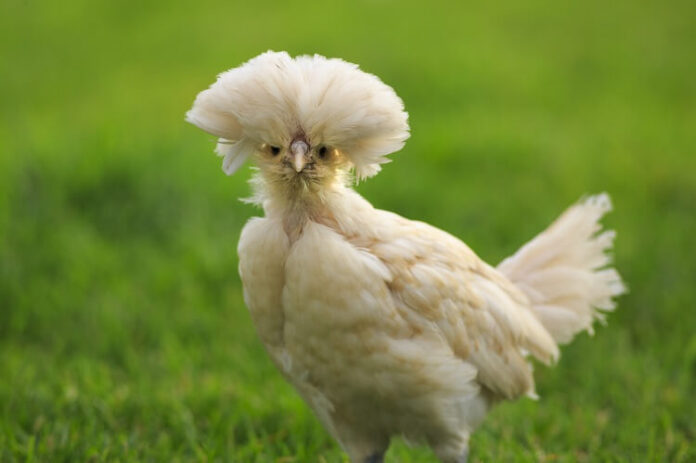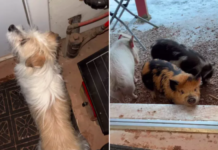Last Updated on July 2, 2021 by Fumipets
The Polish chicken has a rich history, much of which has been lost to the mists of time, but it is adored by ‘chicken lovers’ all around the globe.
There is no other bird that comes close to having as many head feathers as they do — they are really unique in that regard.
They have a spectacular 1970s themed hairstyles….need we say more on this rare and striking bird.?
We go through their disposition, egg-laying skills, recognised variants, and how to tell whether it’s the correct breed for you in our guide to polish chickens.

Overview
| Polish Chicken | |
|---|---|
| Beginner Friendly: | Yes. |
| Lifespan: | 8+ years. |
| Weight: | Hens (4-5lb) Roosters (6lb). |
| Color: | Various. |
| Egg Production: | 2-4 per week. |
| Egg Color: | White. |
| Known For Broodiness: | Rarely. |
| Good With Children: | Yes. |
| Cost of Chicken: | $4-5 per chick. |
History
The origins of this bird are really unknown. There are a few anecdotal accounts of how it entered Europe.
Prominent among the many tales is that the King of Poland was deposed in 1736 and fled to France. He took his beloved Polish chicks with him in his ‘luggage.’
They were the darlings of French society at the time, beloved by the French nobility, and their destiny was secured from that point on. This, as romantic as it may seem, is unlikely to be true.
The reality is likely to be more ordinary. They are first mentioned in the Netherlands, where they may have been brought from Spain. The term Polish is supposed to be derived from the ancient Dutch term pol, which means big head.
The bird appears in paintings from the fourteenth century in which it seems to be a part of daily life, indicating that it has been present for a long time. The Dutch proclaimed it a thoroughbred in the seventeenth century.
The Polish migrated from Europe to England in the 1700s, finally arriving in the United States around 1830-1840.
It was first introduced as a good white egg layer, but the white Leghorn eventually overtook it for better egg-laying.
Its reputation as a fine layer was overshadowed by its odd look, and it was relegated to the status of a ‘ornamental’ breed raised for show rather for eggs.
It’s also known as ‘Paduan,’ ‘Poland,’ or ‘Tophats.’
Recognized Varieties and Breeds
The American Poultry Association accepts both standard and bantam sizes of Polish in their standards book. Polish people are categorised as a ‘Continental’ race.
The following are the categories, colours, and years of APA recognition:
1874: non-bearded white crested black; non-bearded golden; non-bearded silver; non-bearded white; non-bearded white
1883: Golden bearded; silver bearded; white bearded; buff laced bearded.
1938: Non-bearded buff laced.
1963: White crested blue without a beard.
Another type evolved in the latter half of the twentieth century: the Tolbunt.
It’s a gorgeous combination of white, brown, and black that’ll turn heads. Although the APA is yet to recognise this colour, we are convinced it is just a matter of time.
Needless to say, there are several colour combinations and variants available, but if you want a bird that complies with the APA, you must choose the colours listed above.
Appearance
It’s difficult to confuse a Polish chicken since the hen has a nice and clean pom-pom hairstyle.
The roosters, on the other hand, seem to be a ‘wild creature,’ with their feathers giving them a ‘bad hair’ day appearance! The head feathers of both sexes grow up and then cascade over her head and face, creating sight issues in certain cases.
A bony protrusion that emerges from the skull supports the head crest.
Bearded Polish chickens may have a profusion of feathers around the head and face (depending on the type).
The rooster has a distinctive red V-shaped comb that gets lost in his head feathers very often. Wattles are red and earlobes are white.
The legs are grey in appearance, and each foot has four toes. There should be no feathering on the feet or legs.
The male bird may weigh up to six pounds, while the female weighs roughly four and a half pounds. They have white feathers and white skin.

Egg Production
Polish chicken egg output varies significantly depending on the breeding line.
Because the Polish are so inconsistent, it’s best to pick another breed if you want a consistent daily egg layer.
They lay a lot of white, medium/large eggs in general. On average, 150 eggs are laid each year. They seldom brood, as we’ve previously said, although it’s not unusual.
Is The Polish Breed Right For You?
Whether it’s a small agricultural show or a major poultry show, the Polish truly thrives in the show or exhibition arena. If you’re looking for a bird that’s easy to work with and likely to get a lot of attention, this may be the bird for you.
Although purchasing a ‘show-line’ bird is expensive, there are many Polish birds that are affordable to purchase and can be show quality — you just have to shop around after doing your study on the Polish ‘standard of excellence.’
You should be aware that a lot of effort goes into preparing birds for the top exhibitions, but the smaller county events are a little more lenient. These are the locations to start if you want to get a sense of what’s involved.
If, on the other hand, you’re looking for a bird for your kids’ 4H project that’s simple to deal with and placid, not prone to pecking or temper tantrums, the Polish could be a good option.
Given the importance of ‘hands-on’ learning in 4H projects, having a bird that can be touched regularly and flourish is a great benefit.
The majority of people purchase Polish for their backyard flock as a novelty. They are a bird that is likely to bring a grin to your face when you see them! Because of their gentle disposition, they are ideal for raising with little children, and youngsters seem unable to resist hugging and hugging them – all of which the Polish hen will happily endure.
This breed tolerated confinement well, and because of its curious attitude and poor vision, it’s probably best maintained confined for safety reasons. It will undoubtedly need dry quarters over the cold months. When they become wet and then freeze, head feathering may be a huge problem.
The Polish aren’t renowned for their egg-laying abilities anymore, although they do lay a lot of eggs in general, roughly 200 eggs a year.
It takes them a time to get into the habit of laying, but once they do, they may do it very regularly. If you’re looking for an egg-laying machine for your flock, don’t even consider the Polish chicken!
If you have a lot of forceful breeds in your flock, like Rhode Islanders and Welsummers, the Polish may be picked on. Because of their gentle character and nice disposition, they usually rank low in the pecking order – and some birds appear to find tugging the head feathers appealing!
The Polish, like other breeds, are not fitted for free-ranging lives because to their sight impairment. While they like hunting, predators find them easy prey since they cannot see them when they attack.
Finally, head feathers are particularly vulnerable to lice or mite infestations, therefore the chickens should be examined on a regular basis before the situation gets too serious.

Coop Setup
Polish hens will need at least 4 square feet each coop.
You can get away with significantly less coop space if they have a huge place to wander around in outdoors.
The usual 8-inch roosting area is sufficient for these birds. However, if you can, give them a little extra space so that they may stretch out during the summer heat.
For this breed, a regular nesting box (12 by 12 inch) will suffice.
With one nesting box for every three hens, all of your hens will be able to lay an egg in peace.
Temperament
The Polish is typically regarded as a placid and peaceful bird that is excellent for keeping as a pet by children.
They may be frightened and flighty, however this is mainly due to sight issues with the bird’s head feathers. Talking or whistling as you approach the bird will warn them to your presence, making them less likely to be startled.
Trimming the feathers around the face region is often required for the health of the bird, not only to allow the bird to notice predators, but also to keep feathers out of the eye, which may lead to an infection.
Broodiness is uncommon among the hens, though it does vary by strain.
Despite the fact that many Polish are raised only for show or as “eye candy,” other breeders have opted to stay faithful to the birds’ roots. These birds are more likely to be well-layered and have a brooding personality.
They are curious birds that prefer to inspect new objects, therefore they may get ‘stuck’ and need aid to escape. As a result, they are best maintained in solitary confinement, which they endure admirably.
If they get separated from the flock and are unable to see the others, they will often cry out and react to the calls of the other chickens.
Because of their peaceful and tranquil demeanour, they are at the bottom of the food chain. The majority of other chickens can’t stop themselves from plucking those head feathers, resulting in bald birds….or worse.
Polishes are excellent foragers in the yard and are capable of flying, so keep an eye out for them roosting on trees!
They’re also quite tough, surviving in a variety of temperatures, but they don’t perform well in the rain. If the crest gets wet, it should be dried.
In locations where the winters are cold and wet, many breeders place their flocks inside a draft-proofed facility.
While they may be maintained in most climes, extra care must be taken with their loose feathered regions (such as their bouffants) in the winter to prevent them from being wet and freezing. Hypothermia and frostbite may result from freezing feathers.
If you reside in a cold region, it’s preferable to keep this bird indoors during the coldest months of the year if at all possible.
Special Needs and Health Issues
Because of the bony head prominence, the chicks must be closely monitored during the first several weeks of their lives. Because this prominence does not instantly knit together, a well-aimed peck to the head might kill or gravely harm the chick.
If the crest and beard are present, they should be examined for lice or mite infestations on a regular basis and treated as needed. Feathers that obstruct eyesight should be softly clipped to allow the bird to see.
Cutting the feathers during show season will be impossible if you display your birds.
Besides the health issues mentioned above, the Polish chicken is similar to any other chicken.
People who exhibit their Polish spend a lot of time and effort preparing their birds to appear their best on judging days. If you’re interested in showcasing your birds, get in touch with the Polish Breeders Club.
The docility of these birds makes them ideal project birds for children to exhibit at local county fairs, since the Polish is always a bird that draws attention and remarks.

Conclusion
They may not be prolific egg layers, but their cosmetic attractiveness alone makes them deserving of a place in your flock.
The American Livestock Breed Conservancy has them on ‘watch’ status, which indicates their numbers are low and they are being closely watched.
It would be a pity if the last King of Poland went to such lengths just to see his race become extinct!
We hope you will think about adding this lovely bird to your collection.
If you’re willing to learn how to groom your chicken and keep up with their hairstyles,
Polish chickens are a lot of fun to have in your herd. While flighty, they are a terrific discussion starter for those wishing to add this decorative breed to their flock.


















